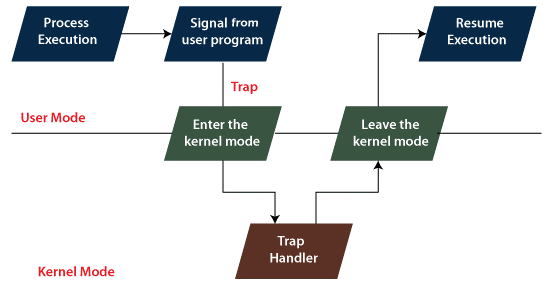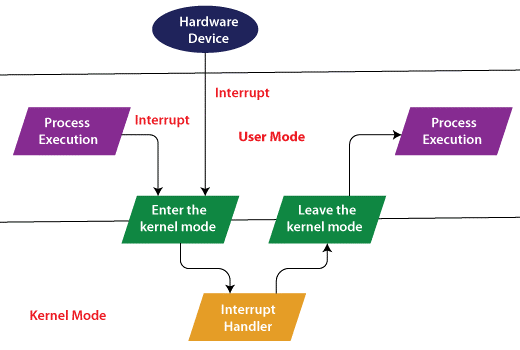Trap vs Interrupt in Operating System
What is Trap in Operating System?
A trap is a synchronous interrupt used to perform functionality when an error occurs in a user process. A trap in an operating system can be triggered by unusual events such as illegal memory access, division by zero, or a breakpoint. A trap switches the operating system's mode to a kernel process. The OS then performs various operations before returning control to the already running process. During a trap, the execution of a process takes precedence over the user code. The trap handler is also synchronous. When the OS detects a trap, the user process is stopped. As soon as the system call completes, the OS restarts and continues to execute user procedures:

A trap can also be thought of as a CPU interrupt handler. The operating system saves stack pointers, registers memory, and resumes prior execution. Let's take a look at an example. Consider a user who is executing an application on an operating system. The program has a print statement:
cout (“%s\n”, str);
This statement is executed by the operating system, which starts the printing process. In addition, the print function in the monitor displays the string returned by the code. Consequently, it is an example of a mesh. The print statement is given first priority by the OS. When the operating system receives this statement, it enters kernel mode. The mode is switched back to user mode after the OS completes its execution.
Trap Mechanism in the Operating System
To make system calls, the user application on the CPU normally uses library calls. The duty of library routine checks is to validate program parameters, establish a data structure to transmit arguments from the application to the operating system's kernel, and then run traps or software interrupts. User programs on the CPU often make library calls to perform system calls. The job of library routine checks is to validate program parameters, create a data structure to send application arguments to the operating system's kernel, and then execute traps or software interrupts.
What is Interrupt in Operating system?
An interrupt is a hardware or software signal that requires the immediate attention of the operating system. This informs the processor that a critical process must be completed immediately. In this scenario the current job process is interrupted. Interrupts are used in all modern computers. In a single application, the OS initiates a sequence of instructions. Further, the execution of the instruction continues until it is completed or an interrupt signal is received. Interruptions in I/O devices are also handled through a special bus control line known as the Interrupt Service Routine (ISR). The INT pin connects hardware devices to the CPU, such as keyboards and network interface cards. When we press any key on the keyboard, interference occurs. When we press any key on the keyboard, interference occurs. The operating system then switches the context and calls the keyboard interrupt handler code. It returns to the previous process after completing the execution:

Interrupt Mechanism in Operating System
A program executes a number of instructions, and the instruction cycle is the amount of time it takes for a program to execute a single instruction. While the CPU is executing program instructions, I/O devices or user programs can cause interruptions. While the CPU is executing the program's instructions, these interrupts will be transmitted as input. After each instruction cycle, the CPU checks whether an interrupt is pending and takes the appropriate action. If there are no outstanding interrupts, the CPU will move on to the next program instruction. If a pending interrupt is detected, the CPU will halt the execution of the instruction and call the interrupt handler software to handle the pending interrupt.
Main Differences between Trap and Interrupt
- A trap is a signal sent by a user's software to the operating system, asking it to take some action immediately. On the other hand, the interrupt is a hardware-generated signal to the CPU that identifies an event that needs immediate attention.
- Also activates a Trap OS features. This trap handler delivers the command. An interrupt, on the other hand, causes the CPU to run the interrupt handler process.
- Is a synchronous process mesh. On the other hand, interrupt is an asynchronous process.
- Another name for software interrupt trap. On the other hand, an interrupt is known as a hardware interrupt.
- A trap is a signal sent by a user's software to the operating system, asking it to take some action immediately.
- It controls the trap handler and performs the unique functionality of the operating system.
- There are two types of events: traps and interrupts. The difference between trap and interrupt is that a trap is triggered by a user program to implement OS functionality. Nevertheless, an interrupt is generated by the hardware device to allow the processor to execute the associated interrupt handler routine.